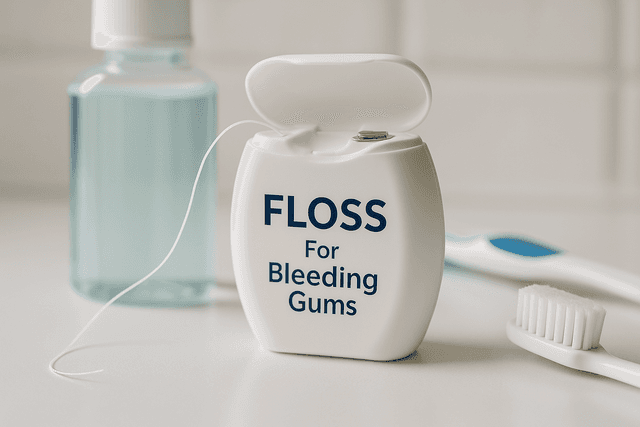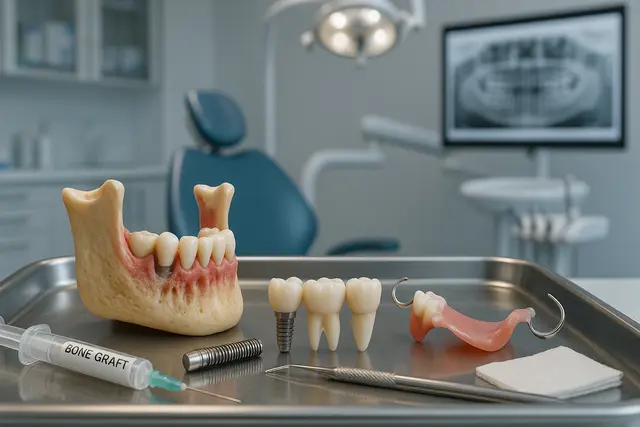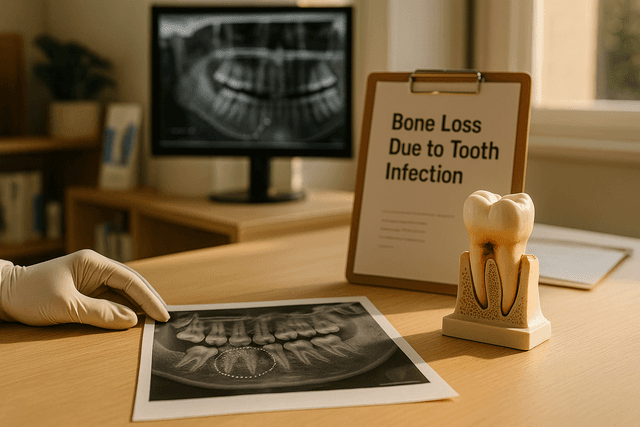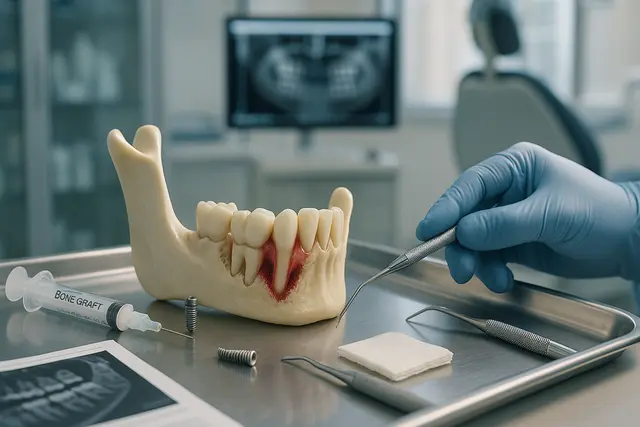Oral Health
6 min read
May 20, 2025
Searching for the Best Floss for Bleeding Gums? Here's What to Use
If your gums bleed every time you floss, you’re probably wondering if you’re doing something wrong, or if flossing is even worth it. Spoiler: it is. The key isn’t to stop flossing, but to start using the right kind of floss and the right technique.

Sometimes the smallest habits make the loudest difference. Take flossing. One string, ten seconds between each tooth, and you’re suddenly steering your mouth away from gingival bleeding, plaque buildup, and tooth decay. Yet if your gums start to bleed the instant the floss sneaks in, it can feel like you’re losing the battle before it even begins.
Don’t toss the string just yet. The right type of floss, paired with the right technique, can turn a painful chore into a simple step toward healthier gums, and a grin you’re happy to flash in every selfie.
Why Are Your Gums Bleeding When You Floss?
Let’s get this out of the way: bleeding gums are not normal. They’re a red flag. In most cases, bleeding means that plaque and food particles have been sitting too long between your teeth and along your gum line. Your body reacts with inflammation, and voilà, your gums bleed. It doesn’t always mean you’re brushing or flossing too hard. Often, it means you’re not brushing and flossing thoroughly enough.
The good news? That bleeding can go away, if you stick with a proper oral hygiene routine. Flossing daily, brushing with a soft toothbrush, and scheduling regular professional dental cleanings can help reverse the inflammation, going beyond the brush to truly elevate your oral wellness. If your gums still bleed after two weeks of consistent flossing, it’s time to ask your dentist to take a closer look. Early gum disease or even periodontal disease may be developing, and catching it early is everything.
How Flossing Actually Helps Heal Bleeding Gums
Here’s the irony: the very thing that might be making your gums bleed, flossing, is also what helps stop the bleeding over time. Daily flossing helps remove plaque and food debris that your toothbrush misses. Over time, this reduces inflammation, prevents gingival bleeding, and strengthens your gum tissue.
You’ll likely notice some bleeding if you’re new to flossing or haven’t done it consistently. That’s normal for the first few days. But don’t give up. Keep going gently, and within a week or two, you should start to see a major improvement in your gum health. This buildup can even contribute to discomfort or pain, similar to common toothache causes and remedies.
The Most Important Rule: Use the Right Floss and Use It Right
Floss is only effective if you use it. And it works best when it fits your teeth, feels good in your hands, and doesn’t shred, snap, or hurt. That means not all dental floss is right for everyone.
Here’s a quick guide to the main types of dental floss to help you find the best match for your mouth:
Waxed floss: Coated for smooth gliding, great for tight teeth, and less likely to shred.
Unwaxed floss: Thinner and squeakier. Better for those who prefer more friction, but it’s prone to shredding in tighter spaces.
Expanding floss: Starts thin and puffs up when it contacts saliva, offering gentle, effective cleaning in wider gaps.
Woven dental floss: Soft, thick, and almost towel-like. Ideal for sensitive gums and removing plaque from larger gaps.
Dental tape: Wide and flat, good for people with more space between their teeth.
Super floss: A must-have for anyone with braces or dental work. Comes with a stiff end, a spongy section, and regular floss for around appliances.
Floss picks: Handy for travel or people with limited dexterity. Just remember: one pick doesn’t cover the whole mouth. Use multiple picks or clean the string portion as you go.
Floss threaders: Essential tools for threading regular floss around braces, bridges, or implants.
Water flossers: A great alternative for people with sensitive gums, tight teeth, or dexterity issues. They use pulsating water to flush plaque and food particles from along the gum line.
Not Sure Which Type of Floss to Use? Here’s How to Decide
If you’ve got tight contacts between your teeth, stick with waxed floss or dental tape. These options are less likely to get stuck or fray. If your gums are sensitive or already bleeding, woven dental floss or expanding floss will feel more forgiving and still do the job of removing plaque.
Got braces, a bridge, or other dental work? Super floss and floss threaders are a must. These tools are designed to get under wires and fixtures without shredding, or if you're managing oral hygiene after a tooth extraction, they make all the difference.
If you’re someone who just won’t floss unless it’s quick and easy, dental floss picks or a water flosser can keep you consistent, because consistency matters more than perfection.
Waxed vs. Unwaxed Floss: Which Is Better for Bleeding Gums?
For most people with bleeding gums, waxed dental floss is the better choice. It glides easily, reduces the risk of cutting into your gums, and is less likely to shred. It also gives you more control around each tooth, which helps you floss gently without irritating your gum line.
Unwaxed floss, on the other hand, is thinner and uncoated. It squeaks (literally) and gives a bit more friction. That’s not necessarily bad, but it’s not ideal if your gums are already inflamed. It also tends to shred more easily, especially in tight spaces.
So unless you have a clear preference, start with waxed. It’s easier to work with and more comfortable for most people, especially those experiencing bleeding.
Floss Picks, Water Flossers, and Other Tools to Consider
Flossing doesn’t have to mean wrestling with string in front of your mirror. If traditional floss doesn’t work for you, consider:
Dental floss picks: Super convenient, especially on the go. Great for kids or folks with arthritis. Just remember to clean them or swap them often.
Water flossers: These use a pulsating stream of water to clean your gum line. They’re ideal for people with sensitive gums, braces, or limited hand mobility.
Super floss and threaders: If you have dental appliances like braces or a fixed bridge, these are non-negotiable. They help you floss completely, without damaging wires or missing plaque.
These tools all help improve your oral health and give you options to make flossing feel less like a chore and more like a quick win for your mouth.
How to Floss Properly Without Making Your Gums Bleed More
You don’t need to floss like a lumberjack. In fact, that’s one of the biggest mistakes people make. Snapping the floss down hard or sawing it back and forth damages your gums and makes them bleed more, not less.
Here’s how to do it right:
Take about 18 inches of floss and wrap it around your fingers.
Slide it gently between your teeth.
Curve it into a “C” shape against the side of the tooth.
Slide it gently up and down under the gum line.
Repeat with a clean section for each tooth.
It might take some practice, especially if you’re new to flossing. But once you get the hang of it, your gums will start to toughen up, and the bleeding will stop.
Still Seeing Blood After Two Weeks? Talk to Your Dentist
If your gums are still bleeding even after using the right floss with proper technique for two full weeks, something else might be going on. It could be gum disease, tartar buildup that needs professional cleaning, or even an underlying health condition, since the link between oral health and overall wellbeing is stronger than many people think.
Make an appointment, or if you don’t have one yet, choose a family dentist you trust. They can check for signs of inflammation, measure gum pockets, and explain what to expect in a check-up. If deeper issues are present, your dentist might refer you to oral surgeons for further care.
Final Thoughts
If your gums bleed, don’t stop flossing, start flossing smarter. Bleeding gums are common, but they’re also reversible with the right type of floss, gentle technique, and consistency. Whether you’re working with waxed floss, woven strands, floss threaders, or a water flosser, the goal is the same: to clean your teeth, reduce plaque, and keep your gums healthy.
All of it adds up to your guide to a radiant smile. So, pick the floss that fits your life. Be kind to your gums. And floss like you mean it.
Why Do My Gums Bleed When I Floss?
Bleeding gums during flossing usually mean your gums are inflamed from plaque or food buildup, not that you’re flossing too hard. This inflammation is your body’s response to bacteria, and with daily flossing and good oral care, the bleeding typically improves within a week or two.
What Type of Floss Is Best for Sensitive or Bleeding Gums?
Waxed floss is generally the best choice for bleeding gums. It glides smoothly, is less likely to shred, and is gentler on inflamed tissue. If your gums are especially sensitive, consider woven or expanding floss for added comfort and effectiveness.
Are Water Flossers and Floss Picks Effective Alternatives?
Yes, both are effective when used properly. Water flossers are great for sensitive gums or braces, while floss picks are convenient for quick use. Just be sure to use multiple picks per session or rinse the pick often to avoid spreading bacteria.
How Long Should It Take for Bleeding Gums to Improve With Flossing?
Most people see improvement within 7 to 14 days of consistent, gentle flossing. If bleeding continues beyond two weeks, it could be a sign of gum disease or another underlying issue. In that case, it’s best to consult your dentist for a professional evaluation.
Read Next
Related Posts

Oral Health
Tooth Replacement Options to Prevent Bone Loss
Losing a tooth isn’t just about appearance, it can have a lasting impact on your oral health, jawbone strength, and overall quality of life. When teeth go missing, the jawbone begins to shrink, which can change your bite, your facial structure, and even your confidence. Fortunately, modern dentistry offers several effective solutions to replace missing teeth and prevent further bone loss.
4 min read
Sep 26, 2025

Oral Health
Bone Loss Due to Tooth Infection Explained: What It Means for Your Oral Health
A tooth infection isn’t just about pain, it can quietly damage the tissues around a tooth and even erode the jawbone that supports your smile. This guide explains how infections start, why they can lead to bone loss, the warning signs to watch for, and the treatments that can stop the spread and rebuild lost support.
5 min read
Sep 25, 2025

Oral Health
Understanding Bone Loss in Teeth: Causes and Treatments That Work
Bone loss in teeth is a silent threat that can compromise your smile, facial structure, and overall oral health. While it often goes unnoticed in the early stages, it can lead to serious consequences if left untreated. Understanding what causes dental bone loss, and how to prevent or manage it, is key to maintaining a strong, healthy foundation for your teeth.
5 min read
Sep 25, 2025
Don’t have time to research every dentist around you?
See why 30k+ patients trusted us